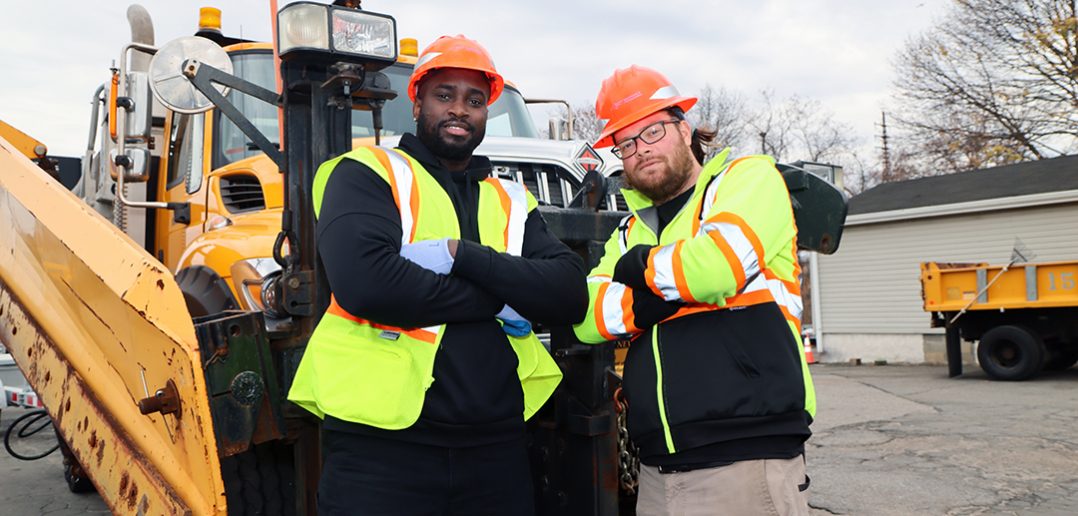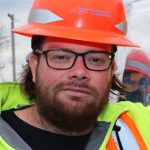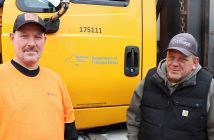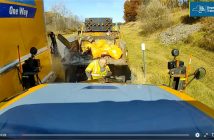When severe winter weather hits, CSEA members head into the storm to keep New Yorkers safe on the roads.
Our union members whose job duties include keeping the roads clear provide a valuable public service in keeping roads safe for emergency vehicles, emergency service workers, people who provide essential public services and traveling community members.
For workers responding to winter storms, including state, county and municipal highway workers, this often means countless hours of road preparation and snow and ice removal to ensure that we can get back to normal as quickly as possible.
“We have already seen snow and ice throughout the state. Please remember to slow down and do not try to pass snowplows as they clear our roads,” said CSEA President Mary E. Sullivan. “We also owe our gratitude to CSEA members throughout the state who work hard to ensure our roads are safe and clear. We also must thank CSEA members who can’t stay home from work when bad weather hits because they are essential employees delivering vital services. Thank you for all that you do!”
Winter plow safety and driving tips:
Yield to snowplows. They travel slower than posted speeds.
Give snowplow driver plenty of room to do their jobs. A truck’s wings and plows can span more than 18 feet. Tow plow trucks are even larger; tow plow blades stretch more than 27 feet and have a total length of 71 feet.
The safest place for you is far behind a snowplow. Put extra space between you and the plow to ensure that snowplow drivers can see you.
Never drive into a spray of snow generated by a snowplow.
Slow down! Never use cruise control on wet or icy roads.
Stay alert. A snowplow weighs 17 times more than a car. In a crash, occupants of a car are much more likely to be seriously injured.
NEVER pass between tandem plows.
Do not drive beside snowplows.
Before you drive, check your tires for adequate tread and inflation, check your windshield wipers and check your windshield washer fluid.
While four-wheel drive (4WD) helps you get moving and keep moving during the storm, it does not help you stop.
Tow plows
Tow plows are used throughout the state, particularly in areas hardest hit by severe winter weather. The tow plow assembly swings out to plow the lane next to the rig, doubling the plowing width. According to the state Department of Transportation, any snowplow creates a ridge of snow to its side that can cause you to lose control of your vehicle. The plow kicks up a snow cloud that causes total whiteout conditions.
You may not be able to see the tow, which can be dangerous for you and plow operators. Because tow plows are much larger than normal snowplows, drivers should use extra caution.
Distracted and drowsy driving also a risk to snowplow operators
Aggressive, distracted and drowsy driving increases the risk that snowplow operators face when they head out in treacherous conditions to clear roads. Don’t talk or text on your mobile phone and be fully alert during winter weather.
Don’t need to be on the roads? Stay home
If you do need to travel, remember that emergency crews’ response times are dependent on roads that are cleared. Remember, plows travel slower and can stop suddenly, so drivers are advised to use caution.
Plow zones are work zones
In 2022 (the most recent year available), 94 highway workers across the United States died while in work zones, a 7% decrease from 2021. (Bureau of Labor Statistics).
More than 37,000 people were injured while in work zones.
About 60 CSEA members have been killed while working on the roads since 1983.
“In the case of inclement weather, the roads are wet and slick and accidents happen in a blink of an eye. Slowing down when you see DOT vehicles gives workers and drivers more reaction time if needed. Every second that you spend being cautious is a second that you are using to avoid a potentially deadly accident.”
— Ryan Moroney, highway maintenance worker 1, state Department of Transportation (North Merrick)
“If I was to send a message, it would be to maintain a safe distance from us when we’re out there. We’re paying attention to a lot of things out there: children playing, people cleaning their cars and slippery conditions. There’s a lot of hazards that we have to pay attention to, and I guess the biggest thing is to maintain a safe distance and watch for us. We watch for you.”
— Harley Ganz, foreman, City of Port Jervis Department of Public Works
“DOT worksites are usually on high-traffic roadways. We have had to move to the opposite side of the roadway because drivers refuse to slow down. We’ve been yelled at, cursed at and had other harsh reactions just because we’re trying to do our job. Drivers don’t consider that we want to get home to our families safely at the end of the day just like they do.”
— Jeffry Loiseau, highway maintenance worker 1, state Department of Transportation (North Merrick)
“It’s simple. We just want to go home to our families at the end of the day just like you do. Be smart on the roads, don’t crowd the plow, and slow down and move over in work zones.”
— Don Campbell, highway maintenance worker 2, state Department of Transportation (Binghamton)








